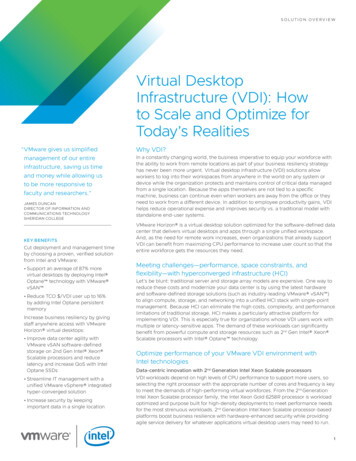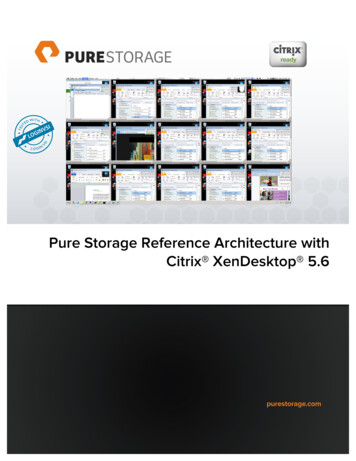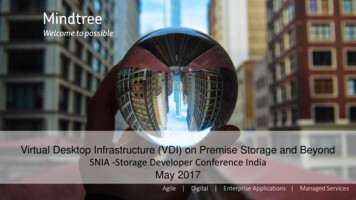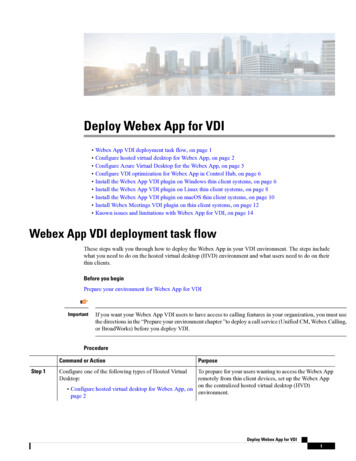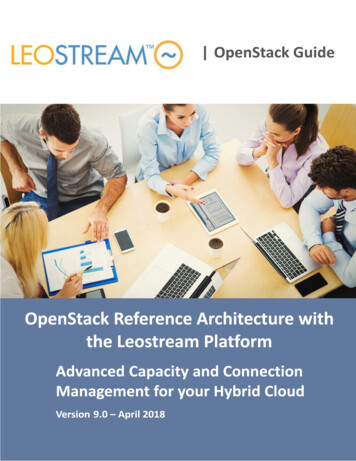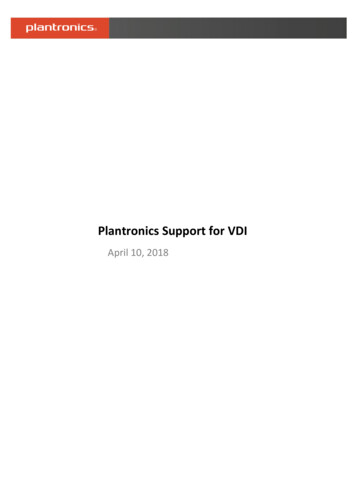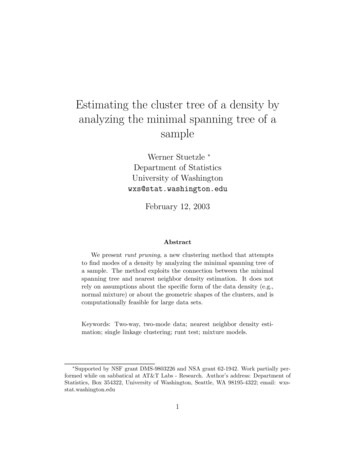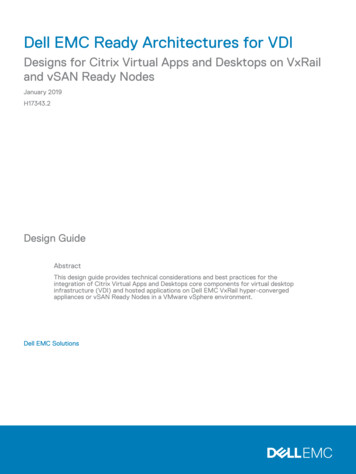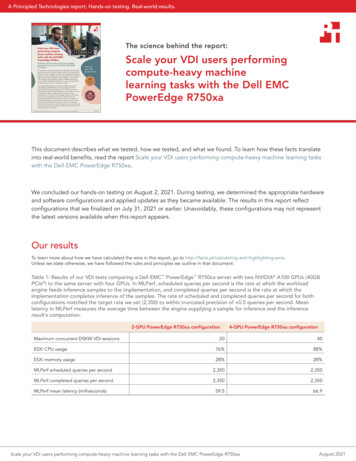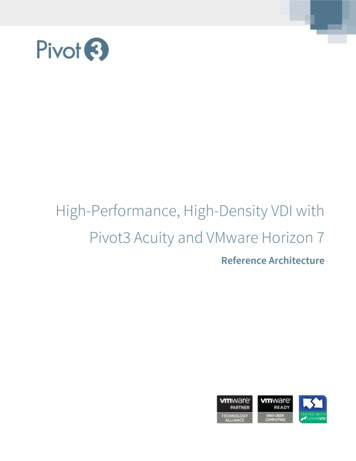
Transcription
High-Performance, High-Density VDI withPivot3 Acuity and VMware Horizon 7Reference Architecture
Reference Architecture – Pivot3 Acuity HCI with VMware Horizon 7How to Contact Pivot3Pivot3, Inc.General Information: info@pivot3.com221 West 6th St., Suite 750Sales: sales@pivot3.comAustin, TX 78701Tech Support: support@pivot3.comTel: 1 512-807-2666Website: www.pivot3.comFax: 1 512-807-2669Online Support: support.pivot3.com Copyright 2018 Pivot3, Inc. 2018 Pivot3, Inc. This document is for informational purposes only. Pivot3 reserves the right to make changes without further noticeto any products herein. The content provided is as is and without express or implied warranties of any kind.2
Reference Architecture – Pivot3 Acuity HCI with VMware Horizon 7Table of ContentsSECTION 1INTRODUCTION .4SECTION 2VDI OVERVIEW .5CRITICAL SUCCESS FACTORS FOR VDI DEPLOYMENTS.5SECTION 3PIVOT3 HCI OVERVIEW .6NVME FLASH DATA PATH AND POLICY-BASED QOS .6DISTRIBUTED SCALE-OUT ARCHITECTURE .6PIVOT3’S PATENTED ERASURE CODING.6VSPHERE INTEGRATIONS & OPTIMIZATION .7RICH DATA SERVICES .7SECTION 4SOLUTION ARCHITECTURE .8SYSTEM CONFIGURATION.8HORIZON VIEW CONFIGURATIONS .8DATASTORE CONFIGURATIONS .8SECTION 5SCALING & SIZING GUIDELINES . 10PIVOT3 ACUITY FLASH SYSTEMS . 10PIVOT3 ACUITY HYBRID SYSTEMS . 11PERFORMANCE VALIDATION AND TEST RESULTS . 11SECTION 6CONCLUSION . 12BREAKING DOWN VDI BARRIERS WITH PIVOT3 HCI . 12APPENDIX ALOGIN VSI RESULTS FOR ACUITY 3-NODE HYBRID . 13KNOWLEDGE WORKER WORKLOAD (2VCPU, 2GB RAM PER USER) . 13TASK WORKER WORKLOAD (1 VCPU, 1GB RAM PER USER) . 14APPENDIX BLOGIN VSI RESULTS FOR ACUITY 6-NODE HYBRID . 16KNOWLEDGE WORKER WORKLOAD (2VCPU, 2GB RAM PER USER) . 16TASK WORKER WORKLOAD (1 VCPU, 1GB RAM PER USER) . 17APPENDIX CLOGIN VSI RESULTS FOR ACUITY 3-NODE FLASH . 19KNOWLEDGE WORKER WORKLOAD (2VCPU, 2GB RAM PER USER) . 19TASK WORKER WORKLOAD (1 VCPU, 1GB RAM PER USER) . 20APPENDIX DLOGIN VSI RESULTS FOR ACUITY 9-NODE FLASH . 22KNOWLEDGE WORKER WORKLOAD (2VCPU, 2GB RAM PER USER) . 22TASK WORKER WORKLOAD (1 VCPU, 1GB RAM PER USER) . 233
Reference Architecture – Pivot3 Acuity HCI with VMware Horizon 7Section 1 IntroductionVirtual desktop Infrastructure (VDI) has been a key enabling technology to enhance employee productivity,improve information security and compliance, and increase IT operational efficiency. However, a close attentionto cost, user experience and scalability of the underlying infrastructure is critical in order to ensure smooth rollout and long-term viability of VDI deployment. Pivot3 Acuity Hyperconverged Infrastructure (HCI) platform, withits policy-based Quality of Service (QoS) that leverages NVMe flash tier, distributed scale-out architecture and richdata services can address these priorities and ensure cost-effective high-performance VDI that scales simply andpredictably.This paper details a reference deployment for implementing VDI using Pivot3 Acuity HCI platform in conjunctionwith VMware Horizon 7. It also outlines guidelines for scaling and sizing VDI deployments in a predictable manner.The architecture is optimized to improve desktop density per node by ensuring unrestricted storage IO access.Login VSI workload testing was conducted to ensure required desktop performance while maximizing desktopdensity per node. Login VSI is the industry-standard performance and scalability testing tool for centralizeddesktop environments. It is a versatile tool that works with VMware Horizon, Citrix XenApp and XenDesktop, andMicrosoft Remote Desktop Services (Terminal Services).4
Reference Architecture – Pivot3 Acuity HCI with VMware Horizon 7Section 2 VDI OverviewVDI enables consolidation and centralization of desktop and end-point operating environments in a virtualizeddatacenter. VDI decouples the end-point devices from their respective operating environments (OS, applications,and data), which allows for centralized management of these environments.VDI helps improve end-user productivity by allowing them to access their desktop environments from any deviceand any location. It helps improve IT security and compliance by centralizing critical data assets, in turnpreventing theft of corporate assets and simplifying data protection. VDI also allows IT organizations to simplifyhow the desktop environments are provisioned and managed, enabling greater operational efficiencies andagility.Critical Success Factors for VDI DeploymentsIt is common for VDI projects to be fraught with challenges. Paying attention to costs, user experience, andscalability are critical when architecting VDI environments.VDI entails moving end-user operating environments and data from inexpensive, consumer-grade end-pointdevices to enterprise-class datacenter infrastructure. This can prove to be an obstacle to justifying return oninvestment (ROI). A close attention to cost, complexity, and footprint is necessary to achieve ROI goals.Another common challenge is unacceptable and inconsistent user experience. As the desktops are centralized inthe datacenter on a common shared storage infrastructure, the storage infrastructure can prove to be an I/Obottleneck when a large number of desktops access storage simultaneously. This can compromise userexperience, hamper productivity, and stall VDI adoption. Ensuring appropriate user experience is a key successcriterion.Many VDI projects start out smoothly in pilot phases, but can soon become too complex and cumbersome toscale in order to accommodate a larger user pool, compromising user experience and complicating growthplanning. The infrastructure supporting VDI deployments must be able to scale predictably in order to simplifyscaling and sizing exercises.Many traditional infrastructure paradigms are inefficient and ineffective in battling these challenges, andorganizations may need fundamentally different approaches to infrastructure. A correctly architectedhyperconverged infrastructure solution can help overcome these challenges and simplify VDI.5
Reference Architecture – Pivot3 Acuity HCI with VMware Horizon 7Section 3 Pivot3 HCI OverviewPivot3’s policy-based, priority-aware, distributed scale-out architecture enables you to deliver on the promise ofvirtual desktops by achieving best ROI, predictable scalability and uncompromising user experience.Pivot3 delivers up to 3X the desktop density per node which slashes infrastructure footprint and the total cost ofownership. Its NVMe flash-optimized data path, coupled with advanced QoS and distributed architecture, deliverssuperior IO performance for an exceptional user experience. With a rich ecosystem of VDI solution providers,Pivot3 can seamlessly accommodate diverse needs and criteria.NVMe Flash Data Path and Policy-Based QoSPivot3’s innovative multi-tier architecture includes ultra-low latency NVMe flash storage tier coupled with policybased QoS. This allows administrators to categorize user pools based on their criticality and performance needsin a simple, intuitive manner by assigning them one of five policies ranging from mission-critical to non-critical.The Pivot3 QoS engine automatically and transparently prioritizes the data placement on the best media, eitherNVMe flash, RAM or SATA SSDs/HDDs. This allows hands-free, policy-based performance management for simpleroperational workflows. The QoS is also schedulable, allowing to set schedules for policy changes. As an example,an administrator might want to tag all datastores containing master images for linked-clones as mission-criticalduring mass login periods to ensure lower boot times and a quick login process.Additionally, the efficient and effective use of NVMe storage tier by Pivot3 QoS eliminates any potential storagebottleneck, allowing for a consolidation of vastly more desktops per node, boosting density and slashinginfrastructure footprint.Distributed Scale-Out ArchitectureThe Pivot3 Acuity platform utilizes a scalable, distributed scale-out architecture. Acuity aggregates all availableresources in all nodes in a cluster to build a unified pool of resources. All volumes, virtual machines, and data setsare uniformly distributed across all drives in the cluster. In a fully populated Acuity cluster, there are 144 SATAcontrolled drives. All these drives participate in all I/O activities, resulting in blazing fast I/O performance for eachdesktop user. This architecture mitigates I/O bottlenecks out of the box, without specialized storage tuning oroptimization, thus ensuring a consistent user experience.Additionally, the cluster is expanded by adding more nodes to accommodate more users. The distributed scaleout architecture ensures linear scalability of capacity, compute, I/O performance, and available bandwidth. Eachnode adds 20Gbps effective bandwidth to the cluster. As a result, predicting incremental hardware requirementsfor anticipated growth is easy and straightforward with Pivot3.Pivot3’s Patented Erasure CodingPivot3 HCI solutions utilize patented erasure coding (EC) to achieve high availability and fault tolerance.Conventional methods to protect against component failures in HCI environments rely upon replicating data setsacross the nodes to ensure availability of data in case of a node failure. This method proves to be inefficient,offering less than 50% usable capacity. Often, two copies are required in order to achieve desired availabilitygoals, slashing usable capacity to 33%. With EC, much higher efficiencies are achieved. In a fully populatedcluster, Pivot3 EC delivers 82% usable capacity. Pivot3 EC provides much better efficiencies while providingprotection from node and drive failures. Additionally, EC eliminates write IO duplication to protect againstfailures, further boosting I/O performance of applications and desktops.6
Reference Architecture – Pivot3 Acuity HCI with VMware Horizon 7vSphere Integrations & OptimizationPivot3 Acuity nodes are preloaded with vSphere, so deployment and setup are a very simple and straightforwardprocess. Acuity vCenter Plugin further simplifies management of infrastructure through integrated management,helping to provision, manage, and monitor Acuity hyperconverged environment from native VMware interfaces.Acuity supports a comprehensive set of vStorage APIs for Array Integration (VAAI) functions that optimize manystorage intensive operations. Further, by leveraging DirectPath (vSphere PCIe Passthrough), Acuity bypasses thehypervisor for any storage-related I/O activities, removing a potential bottleneck in the I/O path and improvinglatency by up to 40%. Acuity also supports a broad set of native VMware capabilities including High Availability(HA), Distributed Resource Scheduling (DRS) and NSX network virtualization. This allows simpler implementationsand administrative flexibility.Rich Data ServicesThe Pivot3 Acuity hyperconverged platform offers a rich set of data services with an all-inclusive licensing model.These data services include Thin Provisioning, space-efficient application aware snapshots and clones, and datareduction (deduplication and compression). This combined with Pivot3’s ability to deliver higher densities byeliminating storage IO bottleneck allows Pivot3 Acuity to consolidate as much as 3X the desktops per nodecompared to alternatives, while delivering 6X the IO performance.7
Reference Architecture – Pivot3 Acuity HCI with VMware Horizon 7Section 4 Solution ArchitectureSystem ConfigurationThis exercise utilized 3-node Pivot3 Acuity Hybrid HCI cluster with two Pivot3 X5-2500 Accelerator nodes and onePivot3 X5-2000 Standard node. Each of the three nodes has 12 1TB SATA HDDs used as a data tier and 2 400GBSATA SSDs used for caching. Each of the accelerator nodes has 1.6TB of NVMe flash storage, which is managed byAcuity as both a persistent data tier and cache. Physical setup specifics are listed in Table 4-1.Figure 4-1 VDI Reference Solution Architecture with Pivot3 Acuity Software PlatformHorizon View ConfigurationsThe standard installation and configuration process that VMware recommends for Horizon 7 can be found here.Pivot3 does not recommend any specific changes to these recommendations. View Connection Server installationtypes, including standard, replica, and security server installations, must be installed on a dedicated physical orvirtual machine that meets specific hardware requirements and uses a static IP address. These requirements alsoapply to replica and security server View Connection Server instances installed for high availability or externalaccess.Datastore ConfigurationsEach VMFS datastore hosted up to 100 desktop VM clones that were created using VMware-linked clonetechnology. The number of datastores varies depending on workload type and number of desktops deployed.All datastore volumes were created with performance QoS policy 1 (Mission Critical) and EC Level 3, as thisexercise was geared towards consolidate one workload type at a time to identify peak density within requiredperformance parameters. It is possible and advisable to design multiple pools of desktops based on theirattributes and assign appropriate performance QoS policies to pools based their requirements and criticality. Thisapproach ensures guaranteed performance for critical desktop users while simplifying performancemanagement.NOTE: Pivot3 Acuity supports VMware DRS and HA capabilities. These should be used to ensure optimal workloaddistribution and uninterrupted operations in case of a host failure.8
Reference Architecture – Pivot3 Acuity HCI with VMware Horizon 7Table 4-1 System Configuration for VDI Reference Solution : Single cluster containing 3 ESXi hosts: 3-node Hybrid (2 Pivot3 X52500 1 Pivot3 X5-2000)Erasure Code LevelAll datastore volumes were assigned Performance QoS policy 1 and EC Level 3.CPUPer node: 2 Intel Xeon E5-2695v4 (36 physical [72 logical] cores)Total System: Hybrid: 3 2 Intel Xeon E5-2695v4 (108 physical [216 logical]cores)RAMPer Node: 768 GBNVMeTotal System: 2 1.6TBDisksPer Node: 12 1TB SATA HDDsVDI EnvironmentVMware Horizon 7.0.2Login VSI Version4.1.3.1493Desktop Workload SpecificsTask Worker: 1 vCPU, 1GB RAM (Windows 7 32-bit)Knowledge Worker: 2 vCPU, 2GB RAM (Windows 7 64-bit)HypervisorESXi 6.0.0.0-5050593Optimized Golden ImageOptimized with VMware tools 11, OS Optimizer, Login VSI Win7 best practices.Login VSI ServerMicrosoft Windows Server 2012 R2Desktop Virtualization ToolVMware Horizon Suite 7.0.2Acuity VersionAcuity 2.0Other Configuration DetailsVMware vCenter Server Appliance 6.0.0 EmbeddedNetwork Switches2 10GbE 10BaseT (SFP Optional)9
Reference Architecture – Pivot3 Acuity HCI with VMware Horizon 7Section 5 Scaling & Sizing GuidelinesAcuity HCI solutions are designed to scale predictably and non-disruptively. This section provides guidelines forsizing and scaling Pivot3 Acuity HCI for Horizon 7 while ensuring required performance. The results outlined hereare based on testing performed by Pivot3 using Login VSI workload testing methodology.Login VSI measures the total response times of several specific, realistic user operations being performed within adesktop workload in a scripted loop. The baseline is the measurement of the specific operational response timesperformed in the desktop workload, measured in milliseconds (ms). More information on how Login VSI workscan be found at https://www.loginvsi.com. For more information on Login VSI workloads, please i-workloads.NOTE: Sizing recommendations in this document are for virtual desktop workloads and do not apply to any otherworkload type. The data represented here should be used as guidance only. Actual workload will vary basedon unique deployment characteristics and customer requirements. Consult your Pivot3 Solutions Architect forunique sizing requirements.Pivot3 Acuity Flash SystemsCluster ConfigurationThe Acuity Flash cluster includes 2 Pivot3 X5-6500 Accelerator HCI Nodes and one or more Pivot3 X5-6000Standard HCI Nodes. Each node has 768GB RAM, 2 Intel E5-2695v4 CPUs with a total of 36 CPU cores and 8 1.6TB SATA SSD drives. Each Accelerator node has 1.6TB NVMe flash storage, which is managed by Acuity as apersistent tier as well as a cache.Recommended Sizing by Workload Type:Recommended Desktop InstancesWorkload Type3-Node 4-Node 5-Node 6-Node 7-Node 8-Node 9-NodeTask Worker (1 vCPU, 1GB RAM)1261161419672320260928983187Knowledge Worker (2 vCPU, 2GB RAM) 951125815661873217024682765Pivot3 recommends an N 1 configuration to mitigate any performance implications of component failures in theinfrastructure. As an example, if the desired user count can be supported on a 4-node cluster, Pivot3 recommends5 nodes in the cluster.Pivot3 recommends scaling Acuity Flash nodes for VDI deployments in clusters consisting of up to 9 nodes foroptimum desktop density and performance. For larger scale deployments, multiple clusters of 9 nodes or less willdeliver better ROI and smaller footprint. As an example, instead of deploying a 12-node cluster, it may be costadvantageous to deploy two clusters of 5 nodes each and support comparable desktop count. Multiple Pivot3clusters can be managed as one domain from one management interface through vCenter. This minimizesmanagement complexity at larger scale.10
Reference Architecture – Pivot3 Acuity HCI with VMware Horizon 7Pivot3 Acuity Hybrid SystemsCluster ConfigurationThe Acuity Hybrid cluster includes 2 Pivot3 X5-2500 Accelerator HCI Nodes and one or more Pivot3 X5-2000Standard HCI Nodes. Each node has 768GB RAM, 2 Intel E5-2695v4 CPUs with a total of 36 CPU cores and 12 2TB SATA HDD drives. Each Accelerator node has 1.6TB NVMe flash storage, which is managed by Acuity as apersistent tier as well as a cache.Recommended Sizing by Workload TypeRecommended Desktop InstancesLogin VSI Workload Type3-NodeTask Worker (1 vCPU, 1GB RAM)1161Knowledge Worker (2 vCPU, 2GB RAM) 3 recommends an N 1 configuration to mitigate any performance implications of component failures in theinfrastructure. As an example, if the desired user count can be supported on a 4-node cluster, Pivot3 recommends5 nodes in the cluster.Pivot3 recommends scaling Acuity Hybrid nodes for VDI deployments in clusters consisting of up to 6 nodes foroptimum desktop density and performance. For larger scale deployments, multiple clusters of 6 nodes or less willdeliver better ROI and smaller footprint. As an example, instead of deploying a 9-node cluster, it may be costadvantageous to deploy two clusters, one with 3 nodes and the other with 4 nodes, to support comparabledesktop count. Multiple Pivot3 clusters can be managed as one domain from one management interface throughvCenter. This minimizes management complexity at larger scale.Performance Validation and Test ResultsPlease refer to the Appendices for Login VSI test results on Acuity Hybrid and Flash configurations. Please notethat the Login VSI results in some instances may indicate a higher desktop count than recommended by Pivot3 inthis section. Pivot3 factors in Login VSI results in all sizing recommendations, and designs all recommendations toensure superior, full-lifecycle performance while optimizing infrastructure footprint.11
Reference Architecture – Pivot3 Acuity HCI with VMware Horizon 7Section 6 ConclusionBreaking Down VDI Barriers with Pivot3 HCIPivot3 provides a policy-based, high-performance hyperconverged platform ideally suited for virtual desktops. ItsNVMe flash-optimized architecture, coupled with advanced QoS, helps lower the total footprint by allowingadministrators to consolidate up to 3X the number of desktops per node while ensuring superior I/Operformance. Pivot3 also simplifies scaling of the infrastructure with its predictable distributed scale-outarchitecture. With Pivot3, organizations can deploy cost-effective, high-performance VDI that is easy to manageand scale.12
Reference Architecture – Pivot3 Acuity HCI with VMware Horizon 7Appendix A Login VSI Results for Acuity 3-Node HybridThis section summarizes the Login VSI tests and their results for Knowledge Worker workload using the Acuity 3Node Hybrid configuration.Acuity 3-Node Hybrid ClusterKnowledge Worker:2 vCPU, 2GB RAM,Windows 7, 64-bit OS961 DesktopsTask Worker:1 vCPU, 1GB RAM,Windows 7, 32-bit OS1367 DesktopsKnowledge Worker Workload (2vCPU, 2GB RAM per user)961 Knowledge Worker desktops were executed in 48 minutes with parameters defined by Login VSI, producingpositive test results.VSImaxCPU13
Reference Architecture – Pivot3 Acuity HCI with VMware Horizon 7IOTask Worker Workload (1 vCPU, 1GB RAM per user)1367 Task Worker desktops were executed in 48 minutes within parameters defined by Login VSI, producingpositive test results.VSImaxCPU14
Reference Architecture – Pivot3 Acuity HCI with VMware Horizon 7IO15
Reference Architecture – Pivot3 Acuity HCI with VMware Horizon 7Appendix B Login VSI Results for Acuity 6-Node HybridThis section summarizes the Login VSI tests and their results for Knowledge Worker workload using the Acuity 6Node Hybrid configuration.Acuity 6-Node Hybrid ClusterKnowledge Worker:2 vCPU, 2GB RAM,Windows 7, 64-bit OS1873 DesktopsTask Worker:1 vCPU, 1GB RAM,Windows 7, 32-bit OS2320 DesktopsKnowledge Worker Workload (2vCPU, 2GB RAM per user)1844 Knowledge Worker desktops were executed in 48 minutes with parameters defined by Login VSI, producingpositive test results.VSImax16
Reference Architecture – Pivot3 Acuity HCI with VMware Horizon 7CPUIOTask Worker Workload (1 vCPU, 1GB RAM per user)2561 Task Worker desktops were executed in 48 minutes within parameters defined by Login VSI, producingpositive test results.VSImax17
Reference Architecture – Pivot3 Acuity HCI with VMware Horizon 7CPUIO18
Reference Architecture – Pivot3 Acuity HCI with VMware Horizon 7Appendix C Login VSI Results for Acuity 3-Node FlashThis section summarizes Login VSI tests and their results for Knowledge Worker and Task Worker workloads usingthe Acuity 3-Node Flash configuration.Acuity 3-Node Flash ClusterKnowledge Worker:2 vCPU, 2GB RAM,Windows 7, 64-bit OS951 DesktopsTask Worker:1 vCPU, 1GB RAM,Windows 7, 32-bit OS1261 DesktopsKnowledge Worker Workload (2vCPU, 2GB RAM per user)951 Knowledge Worker desktops were executed in 48 minutes with parameters defined by Login VSI, producingpositive test results.VSImaxCPU19
Reference Architecture – Pivot3 Acuity HCI with VMware Horizon 7IOTask Worker Workload (1 vCPU, 1GB RAM per user)1261 Task Worker desktops were executed in 48 minutes within parameters defined by Login VSI, producingpositive test results.VSImaxCPU20
Reference Architecture – Pivot3 Acuity HCI with VMware Horizon 7IO21
Reference Architecture – Pivot3 Acuity HCI with VMware Horizon 7Appendix D Login VSI Results for Acuity 9-Node FlashThis section summarizes Login VSI tests and their results for Knowledge Worker and Task Worker workloads usingthe Acuity 9-Node Flash configuration.Acuity 9-Node Flash ClusterKnowledge Worker:2 vCPU, 2GB RAM,Windows 7, 64-bit OS2765 DesktopsTask Worker:1 vCPU, 1GB RAM,Windows 7, 32-bit OS3187 DesktopsKnowledge Worker Workload (2vCPU, 2GB RAM per user)2765 Knowledge Worker desktops were executed in 48 minutes with parameters defined by Login VSI, producingpositive test results.VSImaxCPU22
Reference Architecture – Pivot3 Acuity HCI with VMware Horizon 7IOTask Worker Workload (1 vCPU, 1GB RAM per user)3187 Task Worker desktops were executed in 48 minutes within parameters defined by Login VSI, producingpositive test results.VSImaxCPU23
Reference Architecture – Pivot3 Acuity HCI with VMware Horizon 7IO24
Reference Architecture - Pivot3 Acuity HCI with VMware Horizon 7 5 Section 2 VDI Overview VDI enables consolidation and centralization of desktop and end-point operating environments in a virtualized datacenter. VDI decouples the end-point devices from their respective operating environments (OS, applications,
